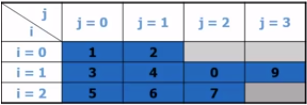数组定义与数组元素分配空间 分开进行
int []a=new int[3]
a[0]=3;
a[1]=9;
a[2]=8;
与C++ C 不同 Java中声明数组不要指定它的长度
int a[5]这是不对的
数组是引用类型
int []a=new int[5] 这里 a就是一个引用
静态初始化 定义数组时候就赋值
int[] a={9,8,7}; 或 int[] a=new int[]{3,9,8};
MyDate[] dates={
new MyDate(22,7,1964),
new MyDate(1,1,2000),
new MyDate(22,12,1964)
} //最后可以多一个逗号 如{3,9,8,}
JAVA中数组分配空间用new 分配了空间的每一个元素都自动赋值0或者null
每个数组都有一个函数length来指明数组的长度,a.length指明数组元素的个数
Java中有一个加强的for循环
int[] ages=new int[10];
for(int age :ages)
{
System.out.println(age);%只读的遍历模式
}
数组复制函数 System.arraycopy
int[] source={1,2,3,4,5,6};//原数组
int[] dest={10,9,8,7,6,5,4,3,2,1};//目的数组
System.arraycopy(source,0,dest,0,source.Length);
%原数组0位置开始复制source.Length个元素到dest,0的位置
数组复制中
-
for循环,效率最低
-
System.arraycopy() 效率最高
-
Arrays.copyOf() 效率次于第二种方法
-
Object.clone() 效率次于第二种和第三种
二维数组
int [][]a={{1,2},{3,4,0,9},{5,6,7}};

int[][]t=new int[3][];
t[0]=new int[2];
t[1]=new int[4];
t[2]=new int[3]; 多维数组得声明和初始化应从高维到低维得顺序进行。
